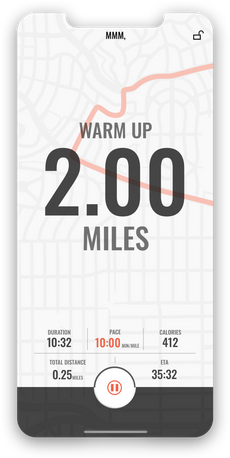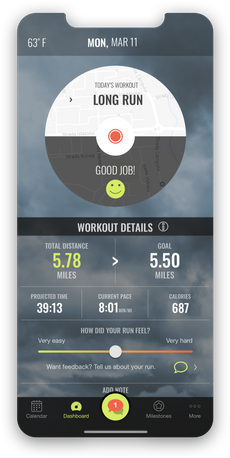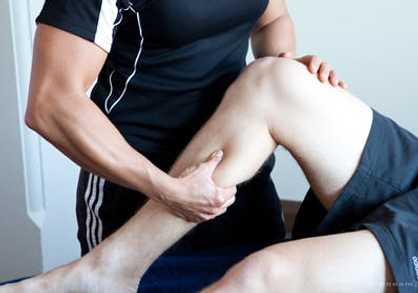10 Dynamic Stretches Before Running
June 10th 2020
Photo by Charlotte Karlsen on Unsplash
Competitive runners often want to push the limit during the grueling training process, but common injuries can prevent them from hitting their next goals. Simple warm-up stretches before running can reduce the risk of injury.
Dynamic stretches are changing the way people look at warm-up routines. It’s a new concept in the fitness industry. Runners can now gain an edge over their competition by adding in these dynamic stretches before running.
At SportMe, we help you develop a training routine that works for you with our customizable app. Trust the pros who use these warm-up stretches to their advantage, and give it a try.
We teach you step by step on how to correctly do a dynamic stretch. You’re welcome to try all or some, please do so at your comfort level.
1. Reverse Lunges
Athletes are typically familiar with basic lunge warm-up exercises, but reverse lunges are just as effective. Reverse lunges actually are safer for your knees, and they focus more on your glutes!
Start with a combination of 2 x 5 reps until your body is warmed up. This can activate the muscles in your legs and hips to jumpstart your whole routine.
Reverse lunges can be a game-changing move for anyone working on their fitness routine. Repeat until you feel warmed up.
2. Plank
The plank exercise works out your core. The stronger your core, the more stable your running will be. This is because your core muscles support your spine. These muscles also help you balance your weight between your lower body and upper body while running.
The plank exercise helps during both short and long-distance runs.
3. 80 Percent Run
Some runners prefer to jog around 80 percent of their maximum speed, which is known as the 80 percent run. This is a popular method to help runners warm-up before a big race. New runners can practice their form with the 80 percent run, which is an excellent warm-up strategy to use over time.
The idea of this warm-up is to get your body adjusted to running before pushing harder. It is also known to help reduce injuries and cramps.
Try our running app to track your run.
4. World's Greatest Stretch
The World’s Greatest Stretch simultaneously works out various muscle groups. It targets specific muscles like the hip flexors, butt, hamstrings, quadriceps, and lateral calf. You can do this warm-up in five minutes before or after your workout, and it’s one of the best dynamic stretches for running.
5. Jump Rope
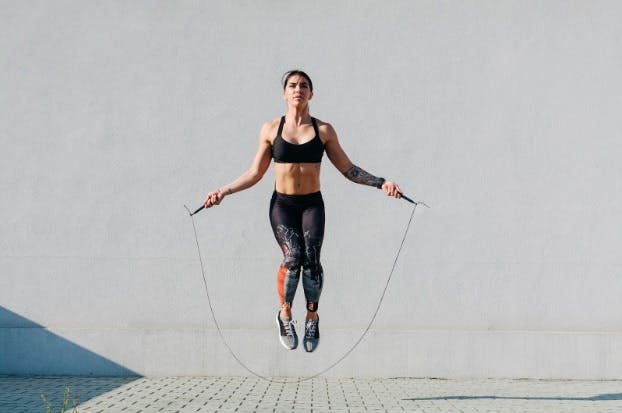
Source: Runner’s Blueprint
Jump roping is quick and easy for every runner. This exercise focuses on completing consecutive reps to warm up the body and prepare muscle groups for extended or high intensity runs.
6. High Knees
High knees are another great pre-run stretch or workout. High knees work out your legs and core.
Start from a standing position. Then, rapidly lift up your knees. Once you fall into a rhythm, you’ll feel like you are jogging in place with a few short pauses in between each knee lift.
7. Side Shuffle
The side shuffle is a dynamic pre-run workout that involves running in the same direction, but with sudden movements. Use your hips to move laterally with your body, which will help exercise several muscle groups along the way. The side shuffle is popular because it takes little energy to do, and it strengthens and improves the range of motion of the lateral hip.
8. Butt Kicks
The butt kick is our favorite dynamic stretch to do before running (we know running). Start with your legs spread slightly apart. Then kick up your heels toward your butt.
As you warm up, you can add speed until you’re running in place. Always remember to drive your heels up toward your glutes.
9. Jumping Jacks
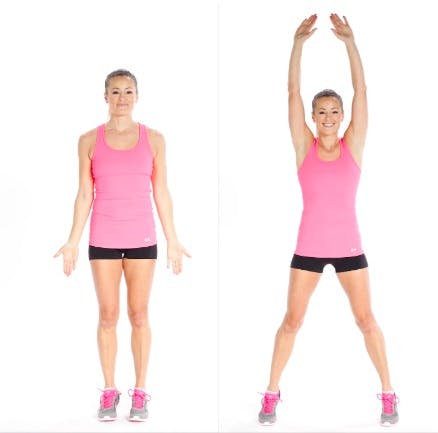
Source: PopSugar
Jumping jacks helps get your heart pumping. Daily jumping jacks can lower blood pressure, reduce fat, tone your muscles, and improve flexibility.
10. Single-Leg Glute Bridge
The single-leg glute bridge will target your glute muscles.
Start by lying on your back with your hands splayed out on your sides. Dig one heel into the ground with your toes facing up. Then extend your other leg until it is straight. Once you have this position, push your hips up. Then come back down slowly while focusing on your core and squeezing your glutes. To start, you can do 5 repetitions with 30-second breaks in between.
Use These Dynamic Stretches Before Running
These dynamic stretches make for excellent pre-run routines. They can also reduce the risk of cramps, fractures, and strains.
Health Benefits of Stretching
For some time, there have been plenty of conflicting perspectives on whether stretching has any benefits before working out. Most commonly it is stated that stretching may be harmful because it can cause injuries. But what if the stretches are performed correctly? This could reduce the number of injuries and allow the benefits to outweigh the risks.
Regular stretching before working out helps to heal and prevent back pain, improves your posture, increases your flexibility, improves your performance during physical activities, increases blood flow to your muscles, helps decrease tension headaches, increases your range of motion, is a great relief for stress, helps to keep your mind calm, and can reduce the risk of injury.
Read on to learn more about the benefits of regular stretching:
1. Increases blood flow to your muscles
Stretching is a great way to help improve your blood circulation because an improved circulation will increase the blood flow to your muscles and result in shorter recovery time and experiencing reduced levels of muscle soreness.
2. Helps to heal and prevent back pain
Muscle tightness may lead to a reduced range of motion, and this increases the chances of straining the muscles in your back. Therefore, stretching may aide heal the existing back injury by stretching the muscles.
3. Improvement of your posture
The reason people have bad posture is due to the imbalance of their muscles. There have been scientific findings showing that strengthening and stretching specific groups of muscles can encourage proper alignment by reducing musculoskeletal pain.
4. Improves your performance during physical activities
Stretching before physical activities have shown to prepare your muscles for the action. Also, it may help to improve your performance in the activity.
5. Increases your flexibility
Stretching can be advantageous by increasing your flexibility, which is vital for your long -term health.
6. Helps decrease tension headaches
Tension headaches can interrupt your daily routine. Supplemental to a healthy diet, plenty of rest, proper hydration, and dynamic stretching can help reduce tension headaches.
7. Increases your range of motion
Regular stretching is useful because it can help improve your range of motion. By allowing your joints to move through its full range of motion, this aids your joints to move more freely.
8. Is excellent for stress relief
When feeling stressed, there is a perfect chance that your muscles are tense. Your muscles tense up in response to emotional and physical stress. Stretching helps to loosen the tight muscles resulting in less stress.
9. Keeps your mind calm
Getting involved in a daily stretching program is not just useful with increasing your flexibility, it can also help calm your mind. As you stretch, it is essential to remain centered by focusing on being mindful and performing meditation exercises, which allows your mind to have a mental break.
10. Can reduce the risk of injury
Flexible muscles will less likely become injured. Therefore, daily stretching will increase your range of motion and reduce the resistance to your muscles.
Stretching is not just important before working out; it is also beneficial after working out. Because if any areas still feel tight, stretching after working out may help reduce the tension in the muscles.
Now that you know about the best stretches to do before you run, keep track of your run times and training plan with our SportMe app. Use our pace calculator and speak to training instructors to help you get your best results.
Want more useful information? Check out our blog to read up on more exercises!


